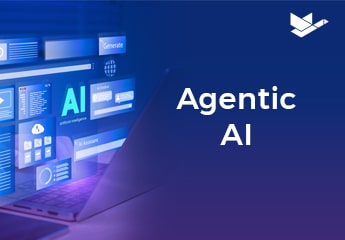Editor’s note: This blog has been updated in Oct 2023 for comprehensiveness.
The Property & Casualty insurance sector has seen a digital transformation, with insurtech companies having a critical role to play. Insurance tech is making customer and back-end processes much more efficient. In 2024, this digital shift is accelerating with an omnichannel approach to customer service and more.
In fact, insurers of all sizes are adopting flexible, evergreen solutions to stay competitive. These 10 tech trends below have become a strategic must-have for insurers to gain the upper hand.
Jump to:
- Predictive Analytics
- Artificial Intelligence (AI)
- Machine Learning
- Internet of Things (IoT)
- Insurtech
- Social Media Data
- Telematics
- Chatbots
- Low Code
- Drones
Download: New market survey report on trends shaping the new standard of insurance
1. Predictive Analytics
Predictive analytics is used by many insurers to collect a variety of data to help them understand and predict customer behavior. However, there are new ways it can be utilized to improve accuracy of data.
In 2024, insurance companies can use predictive analytics for:
- Pricing and risk selection
- Identifying customers at risk of cancellation
- Identifying risk of fraud
- Triaging claims
- Identifying outlier claims
- Anticipating trends
The implementation of predictive modelling strategies has been demonstrated to enhance accuracy and boost revenue for numerous Property and Casualty insurance firms.
A study conducted by McKinsey & Company in 2023 illustrated that the deployment of predictive analytics gave rise to a 10-25% increase in operating profits among the top four performers in EMEA during 2022. Furthermore, this impact is forecasted to expand across the subsequent two years. It’s noteworthy to mention that several firms anticipate realizing an uplift in their operating profits exceeding 25% as a result of predictive analytics.
Use Case: Chubb’s Prevention Services with IoT and Predictive Analytics
Chubb Insurance effectively combines Internet of Things (IoT) and predictive analytics to anticipate and mitigate risks. By continuously monitoring environmental factors through IoT devices, they can predict potential property damage. This proactive approach enables them to offer personalized premiums and helps policyholders avoid costly incidents.
See Also: Learn more about how Duck Creek Insights empowers insurers with smart, actionable data that drives business growth.
2. Artificial Intelligence (AI)
The use of artificial intelligence (AI) has rapidly expanded, with AI-enabled devices becoming commonplace in homes around the world. According to a forecast published by Statista, the utilization of voice assistant technology in the United States is projected to exhibit a steady increase over the next few years. The 142 million users registered in 2022 were anticipated to expand to an excess of 157 million users by the year 2026. So how can this prevalent and accessible technology be leveraged by the insurance industry?
Consumers are always looking for personalized experiences, especially when purchasing something as important as P&C insurance. AI offers insurers the ability to create these unique experiences, meeting the high-speed demands of modern consumers. The key is to use AI’s capabilities to leverage the massive amounts of consumer data available to create personalized experiences based on an individual’s behavior and habits.
Additionally, with AI insurers can improve claims turnaround cycles and fundamentally change the underwriting process. AI also enables insurers to access data faster, and cutting out the human element can lead to more accurate reporting in shorter periods of time.
A report from McKinsey & Company revealed that AI could revolutionize the insurance industry by transitioning it from a “detect and repair” model to “predict and prevent,” which changes the operations for brokers, consumers, and other stakeholders. The result? Better decision-making, increased productivity, cost savings, and superior customer experience.
Use Case: FRISS AI – Efficient Insurance Fraud Detection & Claims Processing
FRISS AI-powered software revolutionizes the insurance sector by rapidly detecting suspicious claims, revealing hidden networks, and identifying underlying patterns. This seamless automation reduces claims handling time by a remarkable 66%, offering real-time insights that yield direct savings. The tool effectively combats fraud and optimizes the claims process.

3. Machine Learning
In 2024, insurance technology trends will be defined by the integration of machine learning operations. This will necessitate multi-departmental collaboration to extract value from data-driven analytical strategies. According to Deloitte Insights, “MLOps encompasses a set of processes and practices’ essential to the deployment and management of machine learning (ML). Without sufficient MLOps capabilities, organizations can struggle to realize the potential of AI.”
Machine learning can not only improve claims processing – it can automate it. When files are digital and accessible via the cloud, they can be analyzed using pre-programmed algorithms, improving processing speed and accuracy. This automated review can impact more than just claims: it can also be used for policy administration and risk assessment.
When it comes to adopting machine learning capabilities, you don’t want to get left in the dust. All signs point to machine learning becoming a common tool in the insurance space. An SMA survey found that 66% of P&C insurance executives believe that machine learning has a high impact potential for commercial lines of business, while 53% of executives believe it has a high impact potential for personal lines.
Use Case: QBE’s Efficient Utilization of Machine Learning for Improved Claims
QBE Insurance has harnessed the power of machine learning with HyperScience’s AI, which led to significant improvements in operational efficiency, faster customer response times, and access to previously inaccessible data.
See Also: Learn more about how Duck Creek Claims empowers carriers with faster claims handling and higher customer satisfaction.
4. Internet of Things (IoT)
Most consumers are willing to share extra personal information if it means saving money on their insurance policies – and the Internet of Things (IoT) can automate much of that data sharing. Insurers can use data from IoT devices such as the various components of smart homes, automobile sensors, and wearable technologies to better determine rates, mitigate risk, and even prevent losses in the first place.
P&C insurers can’t afford to delay in leveraging IoT capabilities, as forecasts project IoT insurance market size to reach multimillion USD by 2029. IoT will bolster other insurance technology with first-hand data, improving the accuracy of risk assessment, giving insureds more power to directly impact their policy pricing, and insurers the opportunity to improve accuracy and revenues.
Use Case: Allstate Partners with Smart Home Security Provider Canary for Home Insurance Discounts
Allstate Insurance has harnessed the power of IoT through partnering with Canary, a smart home security system provider which equips homes with advanced security features like motion-activated recording and one-touch access to emergency services. Users who use Canary’s smart home security system enjoys a 5% discount on Allstate’s home insurance premium.
See Also: Read our blog to find out how utilizing data from smart devices can improve personalized experiences for your customers.
5. Insurtech
Insurtech — or more specifically, insurtech companies — leverage the latest insurance technologies to reduce costs for both customers and insurers, improve operational efficiency, and improve the entire customer experience. While this may sound similar to digital insurance offerings that have been in use for years, insurtech takes those capabilities to the next level.
Gallagher Re’s report indicates a resurgence in Property and Casualty (P&C) insurtech funding in Q3 2022, marking the first increase since Q2 2021. A 20% quarter-on-quarter growth propelled the funding to $1.8 billion, contributing to over 75% of Q3 2022’s total insurtech investment.
The insurtech sector has attracted around $50 billion since 2012, hitting a zenith in 2021 before moderating in 2022. The funding distribution highlights a 60-40 split favoring P&C insurtechs over their life, accident, and health counterparts.
Use Case: Cuvva’s Hourly Car Insurance
Cuvva, a UK-based insurtech startup, provides hourly car insurance through a smartphone app. The innovative model allows drivers to get insured on a car for only as long as they need it, offering flexibility and convenience.
See Also: Read our roundtable report on how embedded insurance works as a profitable business opportunity for insurers.
6. Social Media Data
Social media and its role in the insurance industry is evolving beyond marketing strategies and clever advertisements. Mining social media data is improving risk assessment for P&C insurers, bolstering fraud detection capabilities, and enabling entirely new customer experiences.
Take the Dutch insurance company Kroodle, for example. Their process of interacting with customers is entirely accomplished via social media. Customers log in using their Facebook credentials, and they file claims, get quotes, and request other services via a Facebook app.
Insurance technology can also leverage social media to investigate fraud. Insurers can look at the social activity of insureds and compare it to claims records, looking for any discrepancies. According to Insurtech Insights, the usage of social media data for fraud detection more than doubled from 2014 to 2021.
Use Case: Kroodle – The World’s First Facebook-based Insurer
Kroodle’s process of interacting with customers is entirely accomplished via social media. Customers log in using their Facebook credentials, and they file claims, get quotes, and request other services via a Facebook app.
See Also: Learn more about how Duck Creek and Glia provides unparalleled customer service by meeting customers on their screen.
7. Telematics
Auto policies will continue to be impacted by telematics capabilities. In insurance technology, think of telematics as wearable technology for your car. Cars can now be equipped with monitoring devices — think Progressive’s Snapshot — that measure various indicators such as data on speed, location, accidents, and more, which is all monitored and processed with analytics software to help determine your policy premium.
The benefits of telematics are numerous for both insurers and insureds. Telematics in P&C insurance will:
- Encourage better driving habits
- Lower claims costs for insurers
- Change carrier to customer relationships from reactive to proactive
Use Case: Progressive Insurance’s Snapshot Program for Real-Time Risk Assessment
One use case for machine learning and telematics in insurance is Progressive Insurance’s Snapshot program, which gathers real-time driving data to assess risk accurately. This innovative approach allows Progressive to offer personalized rates based on individual driving behavior.
See Also: Download our eBook to find out more about how you can develop a telematics program with low-code, SaaS policy administration system.
8. Chatbots
According to some estimates, by 2025 95% of all customer interactions will be powered by chatbots.
Utilizing AI and machine learning, chatbots can interact with customers seamlessly, saving everyone within an organization time – and ultimately saving insurance companies money. A bot can walk a customer through a policy application or claims process, reserving human intervention for more complex cases.
Use Case: Geico’s Virtual Assistant, “Kate”
Geico’s “Kate” is a virtual assistant that communicates with customers via text or voice, aiding in policy questions and coverage inquiries, available 24/7. More insurance companies are investing in technology like this, and chatbot capabilities are expected to increase in 2023.
See Also: Read our blog to find out what ChatGPT thinks about its use case in insurance in the near-future.
9. Low Code
Insurers today need to be able to manage software platforms, deploy updates, and get to market with new products efficiently and accurately. While this process used to require a skilled developer or IT team, new advances in software-specific coding platforms have made this process easier than ever before.
Low-code configuration tools allow business stakeholders – not just IT professionals – to update and manage apps and software using an intuitive, user-friendly drag and drop functionality. With moderate or even elementary app and software experience, insurers will be able to quickly implement new and different user interface (UI) features that customers demand, in a fraction of the time usually required.
The biggest benefits of low-code development are:
- Drastically increased speed to market
- Widespread app development across organization
- The ability to build foundational features that can be expanded upon
- Empowering employees to take control of their work/offerings
Statista, it was revealed that nearly a third of participants (29%) found that low-code development operates at a speed 40-60% faster than its traditional counterpart. As such, it’s hardly a surprise that low-code solutions are rapidly becoming the go-to for application development. This shift is so pronounced that a Gartner report also predicted that low-code methodologies will be responsible for more than 65% of all app development efforts by 2024. Quite the leap, wouldn’t you say?
Use Case: BHSI Developed Core Policy & Claims Functionality in Just 8 Weeks with Duck Creek
BHSI Australia had an ambitious goal – to launch over 40 products in just 18 months with a fully-functioning policy and claims system, while keeping IT costs to a minimum. Duck Creek’s low-code solutions helped them to reach claims-readiness in just 8 weeks, and BHSI now has over 250 commercial products above 9 lines of businesses.
See Also: Learn more about Duck Creek Suite’s Low-Code Capabilities and how insurers benefit from it.
10. Drones
Insurers are taking to the sky, or at least their drones are. Unmanned drones are an insurance technology tool that will be utilized more by carriers in 2024. They can be used across many stages of the insurance lifecycle – collecting data to calculate risk before issuing a policy, aiding in preventative maintenance, and assessing damage following a loss.
Use Case: Faster Claims Investigation and Processing with Drones
Allstate, Liberty Mutual, and other large American firms were among the first adopters of drones for day-to-day claims investigations. Drones are revolutionizing the insurance sector by enabling quick, safe, and cost-effective inspections and data collection. They not only mitigate the risks associated with manual inspections, such as climbing onto roofs, but also significantly improve the accuracy and efficiency of claims investigations. With their robust functionality, including thermal imaging and 3D modeling, drones are becoming an essential tool in the insurance industry.
See Also: Learn more about how insurers from different lines of businesses are using Duck Creek Suite to speed up their processes.
Duck Creek Suite – The Best Low-Code SaaS Investment for Insurers
Duck Creek Suite is a comprehensive, integrated suite of software solutions provided by Duck Creek Technologies, designed to manage all aspects of an insurance business. It includes tools for policy administration, billing, claims management, insights, and rating, enabling insurers to streamline their processes, enhance customer experience, and accelerate product development. This suite serves as an insurance core system, which has the potential to transform the insurance landscape by providing digital and automation capabilities, driving operational efficiency, and enabling insurers to adapt quickly to market changes.
P&C carriers are always searching for the latest and greatest developments in insurance technology. It helps them not only stay ahead of their competitors, but also deliver the experiences customers expect in the modern market. With all of the innovation going to market in recent years, from smart home technology to insurtechs and microservices, the upcoming years will be a very interesting to watch for insurance technology developments. Stay tuned…





